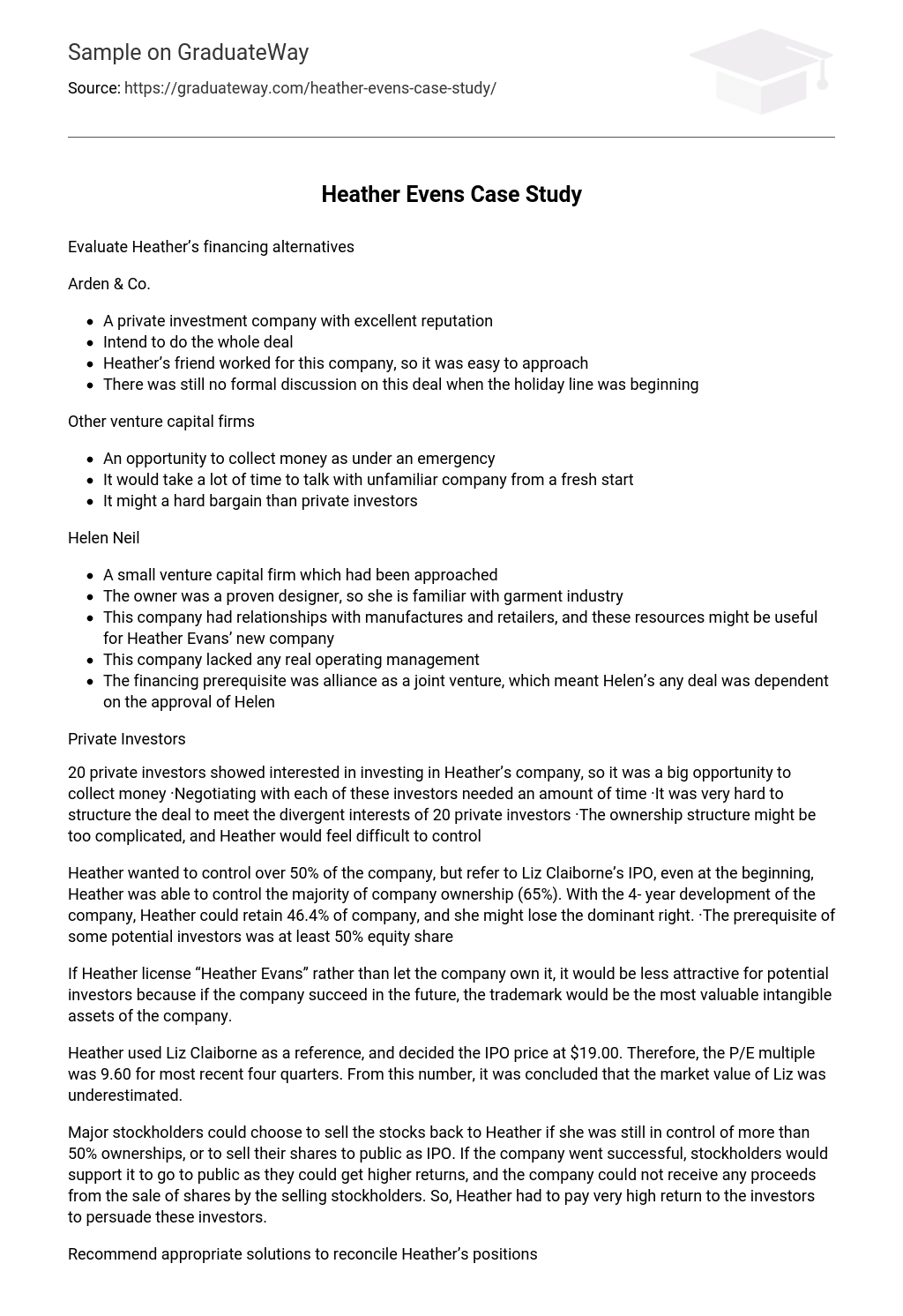Evaluate Heather’s financing alternatives
Arden & Co.
- A private investment company with excellent reputation
- Intend to do the whole deal
- Heather’s friend worked for this company, so it was easy to approach
- There was still no formal discussion on this deal when the holiday line was beginning
Other venture capital firms
- An opportunity to collect money as under an emergency
- It would take a lot of time to talk with unfamiliar company from a fresh start
- It might a hard bargain than private investors
Helen Neil
- A small venture capital firm which had been approached
- The owner was a proven designer, so she is familiar with garment industry
- This company had relationships with manufactures and retailers, and these resources might be useful for Heather Evans’ new company
- This company lacked any real operating management
- The financing prerequisite was alliance as a joint venture, which meant Helen’s any deal was dependent on the approval of Helen
Private Investors
20 private investors showed interested in investing in Heather’s company, so it was a big opportunity to collect money ·Negotiating with each of these investors needed an amount of time ·It was very hard to structure the deal to meet the divergent interests of 20 private investors ·The ownership structure might be too complicated, and Heather would feel difficult to control
Heather wanted to control over 50% of the company, but refer to Liz Claiborne’s IPO, even at the beginning, Heather was able to control the majority of company ownership (65%). With the 4- year development of the company, Heather could retain 46.4% of company, and she might lose the dominant right. ·The prerequisite of some potential investors was at least 50% equity share
If Heather license “Heather Evans” rather than let the company own it, it would be less attractive for potential investors because if the company succeed in the future, the trademark would be the most valuable intangible assets of the company.
Heather used Liz Claiborne as a reference, and decided the IPO price at $19.00. Therefore, the P/E multiple was 9.60 for most recent four quarters. From this number, it was concluded that the market value of Liz was underestimated.
Major stockholders could choose to sell the stocks back to Heather if she was still in control of more than 50% ownerships, or to sell their shares to public as IPO. If the company went successful, stockholders would support it to go to public as they could get higher returns, and the company could not receive any proceeds from the sale of shares by the selling stockholders. So, Heather had to pay very high return to the investors to persuade these investors.
Recommend appropriate solutions to reconcile Heather’s positions on these issues with potential investors.
Control
At this stage, Heather was passive because she needed money to start her company, so she had fewer choices. Big potential investors wanted to dominate the new company, and the private investors would make the ownership constitute too complicated to control. According to Heather’s requirements, what she expected most was to manage this company by herself, so, our team thinks that she was better to choose private investors. Because each private investors has few shares of the company, so Heather could control the company for longer time though she would take a lot of time to negotiate with each of them and be more stressed in future management.
Licensing
Most private investor had a request that the company was better to own the trademark rather than licensing. Licensing the trademark was under the situation that she had to leave the company. As private investors were easier to negotiate and better for her position in company, so she could give up licensing temporally.
Valuation
Though Heather Evens and Liz Claiborne were both designed for office ladies, Liz sold in the “better sportswear” range and Heather targeted on the high-income office ladies. As apparel industry is a high-profit field, Heather’s target market was still a gap, Heather had a big probability to recover the cost and even gain earnings. Therefore Heather could decide a higher price like $25 compare to $19 of Liz’s IPO price.
Exit Strategy
Heather could buy back the stock shares gradually when the company began to make money. Always, it is very hard to buy back equity when the company has been very successful because all the investors have seen the value in the stocks, so Heather should take actions early. She might begin negotiating with the investors holding fewer shares.





